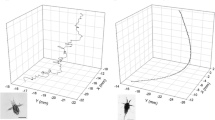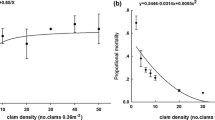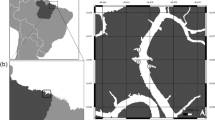Synopsis
Swimming speed and swimming path of goldfish and tetra larvae were studied in aquaria containing food patches composed of decapsulated cysts and immobilized nauplii of Artemia salina or sparsely distributed prey. The mean swimming speed of starved larvae in the medium without food was about four times higher than the speed of larvae feeding in a patch. Satiated larvae swam about 1.5 times slower than hungry fish. Consumption of single prey items by starved larvae caused the following sequence of swimming responses: ‘handling pause’ (cessation of swimming), slow swimming in a restricted area, and fast swimming (approximately twice as fast as hungry larvae before encountering food) accompanied by a widening of the area searched (‘area increased searching’). Mean swimming speed was constant over a broad range (101–103 ind·1−1 of food density, although at extreme (high or low) values of food density it depended on swimming responses of the predator. Frequency of visits to the different parts of the aquarium strongly depended on encounters of hungry fish with food particles or patches.
Similar content being viewed by others

References cited
Beukema, J.J. 1968. Predation by the three-spined stickleback (Gasterosteus aculeatus L.). Behaviour 31: 1–126.
Blaxter, J.H.S. & M.E. Staines. 1971. Food searching potential in marine fish larvae. pp. 467–485. In: D.J. Crisp(ed.) Fourth European Marine Biology Symposium, Cambridge University Press, Cambridge.
Braum, E. 1967. The survival of fish larvae in reference to their feeding behaviour and the food supply. pp. 113–131. In: S.D. Gerking(ed.) The Biological Basis of Freshwater Fish Production, Blackwell Scientific Publications, Oxford.
Dabrowski, K., F. Takashima & Y.K. Law. 1988. Bioenergetic model of planktivorous fish feeding, growth and metabolism: theoretical optimum swimming speed of fish larvae. J. Fish Biol. 32: 443–458.
Evans, B.I. & W.J. O'Brien. 1986. An analysis of the feeding rate of white crappie. Env. Biol. Fish. 7: 299–306.
Evans, B.I. & W.J. O'Brien. 1988. A reevaluation of the search cycle of planktivorous arctic grayling, Thymallus arcticus. Can. J. Fish. Aquat. Sci. 45: 187–192.
Houde, E.D. & R.C. Schekter. 1980. Feeding by marine fish larvae: developmental and functional responses. Env. Biol. Fish. 5: 315–334.
Hunter, J.R. & G.L. Thomas. 1974. Effect of prey distribution and density on the searching and feeding behaviour of larval anchovy, Engraulis mordax Girard. pp. 559–574. In: J.H.S. Blaxter(ed.) The Early Life History of Fish, Springer Verlag, Berlin.
Ivlev, V.S. 1944. Time of hunting and the path passed by fishes with reference to the density of population of the prey. Zool. Zh. 23: 139–145. (in Russian).
Marcotte, B.M. & H.I. Browman. 1986. Foraging behaviour in fishes: perspectives on variance. Env. Biol. Fish. 16: 25–33.
Mikheev, V.N. & D.S. Pakulska. 1988. Swimming activity in foraging behaviour of Hemigrammus caudovittatus larvae. Voprosy Ichthiologii 28: 100–1013. (in Russian).
Milinski, M. 1990. Information overload and food selection. pp. 721–737. In: R.N. Hughes(ed.) Behavioural Mechanisms of Food Selection, NATO ASI series G 20, Springer Verlag, Heidelberg.
Miller, R.C. 1922. The significance of the gregarious habit. Ecology 3: 122–126.
Munk, P. & T. Kiorboe. 1985. Feeding behaviour and swimming activity of larval herring (Clupea harengus) in relation to density of copepod nauplii. Mar. Ecol. Prog. Ser. 24: 15–21.
O'Brien, W.J., B.I. Evans & G. Howick. 1986. A new view of the predation cycle of a planktivorous fish, white crappie (Pomoxis annularis). Can. J. Fish. Aquat. Sci. 43: 1894–1899.
O'Brien, W.J., H.I. Browman & B.I. Evans. 1989. Search strategies of foraging animals. Amer. Scientist 78: 152–160.
Rashevsky, N. 1959. Some remarks on the mathematical theory of nutrition of fishes. Bull. Math. Biophysics 21: 161–183.
Rosenthal, H. & G. Hempel. 1970. Experimental studies in feeding and food requirements of herring larvae (Clupea harengus L.). pp. 344-364. In: J.H. Steele(ed.) Marine Food Chains, Oliver & Boid, Edinburgh.
Smith, J.N.M. 1974. The food searching behaviour of two European thrushes: I. Description and analysis of search paths. Behaviour 48: 276–302.
Thomas, G. 1974. The influence of encountering a food object on the subsequent searching behaviour in Gasterosteus aculeatus L. Animal Behaviour 22: 941–952.
Tinbergen, N., M. Impekoven & D. Frank. 1967. An experiment on spacing as a defence against predation. Behaviour 28: 307–321.
Vlymen, W.J. 1977. A mathematical model of the relationship between larval anchovy (Engraulis mordax) growth, prey microdistribution, and larval behaviour. Env. Biol. Fish. 2: 211–233.
Waddington, K.D. & B. Heinrich. 1981. Patterns of movement and floral choice by foraging bees. pp. 215–230. In: A.C. Kamil & T.D. Sargent(ed.) Foraging Behaviour: Ecological, Ethological and Psychological Approaches, Garland STPM Press New York.
Warburton, K. 1990. The use of local landmarks by foraging goldfish. Animal Behaviour 40: 500–505.
Ware, D.M. 1975. Growth, metabolism and optimal swimming speed of a pelagic fish. J. Fish. Res. Board Can. 32: 33–41.
Welty, J.L.C. 1934. Experiments on group behaviour of fishes. Physiological Zoology B7: 85–128.
Werner, E.E. 1974. The fish size, prey size, handling time relation in several sunfishes and some implications. J. Fish. Res. Board Can. 31: 1531–1536.
Author information
Authors and Affiliations
Rights and permissions
About this article
Cite this article
Mikheev, V.N., Pavlov, D.S. & Pakulska, D. Swimming response of goldfish, Carassius auratus, and the tetra, Hemigrammus caudovittatus, larvae to individual food items and patches. Environ Biol Fish 35, 351–360 (1992). https://doi.org/10.1007/BF00004987
Received:
Accepted:
Issue Date:
DOI: https://doi.org/10.1007/BF00004987



